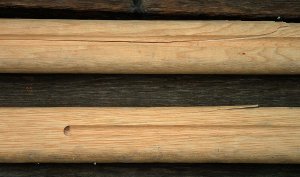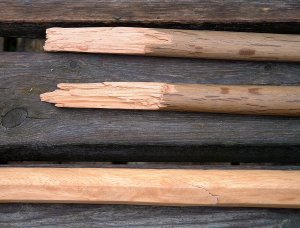 Kim
Taylor's occasional column with no clever name
Kim
Taylor's occasional column with no clever name
 Kim
Taylor's occasional column with no clever name
Kim
Taylor's occasional column with no clever name
"Will your bokken stand up to full contact practice?"
I get a lot of that sort of question, along with "What's the best wood for hard contact?" and "I'd like a bokuto that is the same size and shape as my shinken with the same balance but just a bit heavier". But my all-time favourite has to be "are your bokken guaranteed for life against breakage"?
Let me answer the last question first. No. I know most of the other practice sword makers around North America and I don't know any one of them who, even if they once had such a guarantee, still offers it. Why? Because someone, somewhere is going to figure out how to break anything you make, from any material at all, up to and including steel, hell I've done it myself. As a kid I once took a stubby, thick, prybar type hunting knife and started to split kindling with it for a campfire. I placed the edge on a stick end, grabbed another stick and hit the back near the point to drive the blade through the wood. I wedged the blade firmly into the wood alright, and snapped it off at the hilt within 3 not particularly hard hits. Sent the knife back to the manufacturer and got exactly nothing in return, not even a letter that said "our knives aren't axes". Stupid marketing but hey, do they really want a customer that uses their product in a dangerous and unsafe way?
Do I?
OK let me ask another question. Would anyone out there take a Japanese sword and swing it full force into another steel blade and expect it to last? OK that's not fair is it? Shinken are very expensive so you wouldn't want to ruin a $600 polishing job, or snap a $5000 blade right? So let's talk wood which is intended as a practice weapon to keep our shinken from being damaged. In fact, let's talk a very chunky, tough piece of wood... a baseball bat. Now, would anyone swing two baseball bats into each other repeatedly and at "full contact" and expect them to last for more than about an hour of "practice"? No? So why a bokuto?

Fig 1. Hickory bokuto and jo broken during demonstrations on how
to generate power in the swing.
Note that they split rather than snapped in half.
Enough sarcasm, let's talk about what wooden weapons are designed for shall we? They are, first and foremost, to allow students to practice in a controlled and concentrated manner without killing each other. This is accomplished by having something that is lighter than your steel blade (thus more controllable when swinging at your practice partner) and without an edge (bruises instead of cuts is a good thing), which is essentially disposable, so you can throw it away at the first sign of a crack or split (whereas if it was as expensive as a shinken you might be tempted to get just a little bit more life out of it). It can also be sanded down to get rid of the sawtooth dents that you would rapidly get in a metal practice blade.
Please note well that the Western term for the equivalent of a bokuto is "waster". I've seen it written as "waister" but I can't imagine why, it's obvious to anyone who has practiced martial arts which involve any kind of contact between blades that a wooden sword is intended to be "wasted". (See Fig. 2) I've watched some of the western folks revive their martial arts, and I've seen the bruises, broken bones and lacerations as they slowly work their way from "full contact, realistic training" back to something that will let them go to work on Monday morning after a weekend practice. The Japanese sword arts have long since been adapted to methodologies that allow students to train with enough safety that the arts weren't outlawed outright to prevent too many of the students from being kept away from their livelihood. Wooden swords mean controlled, light and angled contact. If you want "full contact" you use the proper protective equipment and weapons... you use kendo armour and bamboo shinai.

Fig. 2. Hickory wasters that have been broken, again note that they
have split rather than snapped in half.
What about other cultures? How about the Filipino stick arts? Well I've been asked if I can recommend a wood for arnis that is "as tough as rattan". Hunh? Rattan is a vine, it's light and won't usually kill you if you get hit too hard by mistake during practice. After too much stick to stick hitting it goes floppy instead of snapping in two. What happens if you substitute a hard, stiff, heavy wood for rattan during practice? It may last longer if you tend to whack them together too hard, which is of course the reason for looking at wood. But, even if you're lucky and the students don't make mistakes and kill each other with full force strikes to the head, eventually the sticks get beat up enough to snap and go flying across the room. They have wood in the Philipines, they chose rattan for a reason.
Lighten up on those strikes. With wooden sticks you work in patterns slowly, carefully, and lightly. You don't hit full force unless you don't know what you're doing.
England? Well there was once the singlestick, and with that you might have practiced to "pinks", where you won the bout (oh botheration, call it a duel) if you opened an inch of blood on your opponent's head. They used wood. Which wood? Well it wasn't oak and it wasn't an inch thick and it wasn't anywhere near as heavy as a backsword. It was a 1/2 to 3/4 inch wand of ash which, as likely as not was kept in a barrel of water. Ash is light, not prone to breaking, and very flexible. Soaked in water it gets even more flexible. Would it have dented with all that contact? You're darned tootin' it would have, and it would have been replaced at the first sign of cracking or splintering. Wonder how many of the old singlestick boys lost an eye by mistake.
Wooden weapons are also, moreso in the past than now, a way to allow practice without damage to the steel sword. Unlike today when we can pick up Chinese made metal blades for a couple hundred dollars, putting them into the price range of a wooden practice sword, the sword student of the past would have spent a substantial proportion of their yearly wage on a steel blade. Think what a traditionally forged blade costs today... think most of a year's wage. We're not talking about collectors paying $5000 for a 400 year old antique, that blade has already been paid for by the first fellow who paid the smith for it. Aftermarket prices don't take into account the cost of production, only what it's worth to a collector.
Back to the original questions.

When I get questions about "full contact" I worry, quite often in fact, that people are misunderstanding what bokuto are meant for. They are not, were not, never will be intended as "safe" for full contact. As long as you are swinging lumber at each other you are at some risk of being hurt, if you do it without proper training and supervision, if you do it with weapons that are in poor condition, if you do it without the greatest concentration and care you can manage, you could be injured. You wouldn't swing a hockey stick or baseball bat full force at a teammate would you? And they've usually got helmets on! So why would you do it with a bokuto at someone who is unarmoured? The proper safety equipment exists to make that kind of practice survivable. Use bamboo and kendo armour, use foam chambara weapons and helmets, use rattan ulysses or ash singlesticks if you must learn through welts, but please, please, use wood and metal only in light, controlled kata, under proper supervision from trained and experienced instructors. Or if you don't, at least buy your bokken from someone else so I can sleep at night.